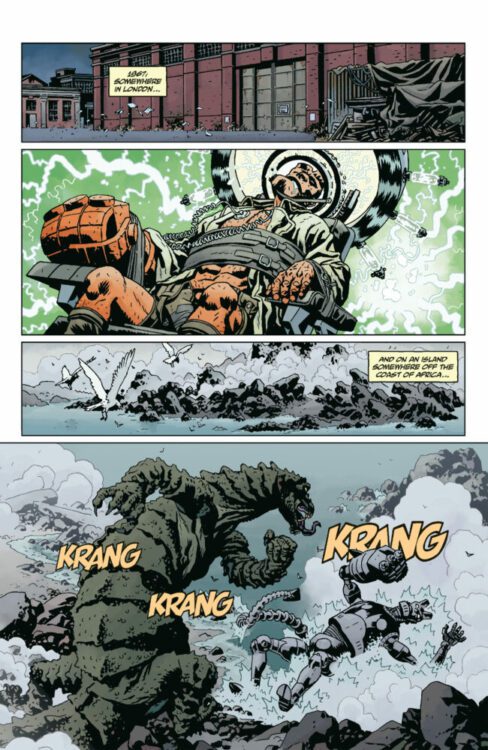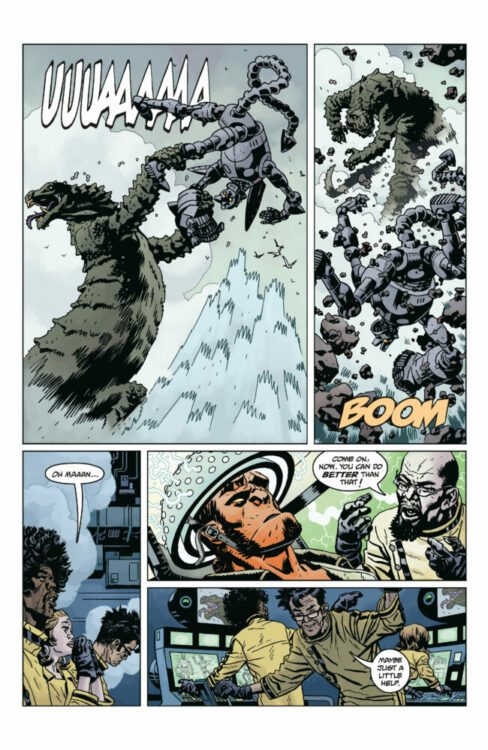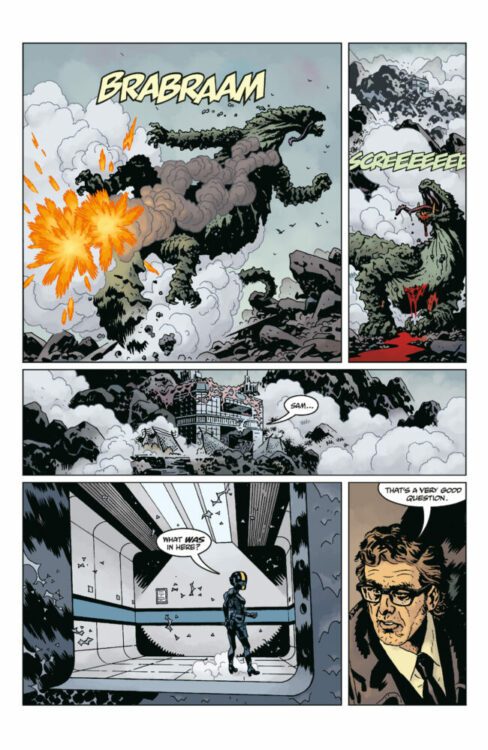Dark Horse Comics’ Giant Robot Hellboy does it all. It has the pulpy action-packed thrills of a kaiju match coupled with Hellboy‘s trademark mythological depth. Writer Mike Mignola, artist Duncan Fegredo, colorist Dave Stewart, and letterer Clem Robins yank us back into the fray with this issue, but they balance the chaos by hinting at meaningful truths that are hiding just beneath the surface.
About the Issue (from Dark Horse):
While Hellboy’s robotic counterpart battles giant monsters on a faraway island, the scientists running the mission scramble when things at the lab get more than a little out of hand.

Writing
People have often said that comic books are today’s version of mythology. That’s never been more true than in the case of Mignola’s Hellboy Universe. His stories have subtly intertwined over the course of its decades of publication. Lobster Johnson, the Black Flame, the Hyperboreans, and even Frankenstein’s monster all tell us a little more about each other. From the dawn of creation to its final moments, no story is truly insulated in this sprawling world Mignola has masterminded. Except a story about Hellboy controlling a mech suit to fight monsters on an abandoned island, right? Surely there’s nothing deeper going on there? Guess again.
Mignola separates Giant Robot Hellboy #2 into two different narratives. The first is as simple as it gets. We see the titular robot beating monsters into a bloody pulp. It’s all sound effects and explosions. There’s no dialogue at all. The second narrative is a little more mysterious. The shadowy corporation that has kidnapped Hellboy — who may be somehow related to our friends at the BPRD or perhaps their UK counterpart — have sent one of their agents into an abandoned building to look for clues to what’s going on. The agent’s handlers piece together scraps of information to try and make sense of what they’re seeing. But they know more than they’re telling us. Mignola feeds the reader details sparingly, keeping the stakes high and the mystery intact. But what he does tell us shows that he has big things planned for the final issue, and this series has more going on that what first meets the eye.

Art
Fegredo’s art is atmospheric and dynamic. When he places a scene in an abandoned office, you almost want to brush the cobwebs out of your way as you follow along. And when he draws a battle sequence, the detailed carnage and destruction has you wondering if you should run for cover before reading more. But there’s something even more brilliant about Fegredo’s action scenes than the riveting displays of power. Instead of getting lost in the mayhem, Fegredo guides us through it with a play-by-play of images. We see Hellboy’s mechanical avatar pulling his fist back in one panel and then it making contact in the next. The giant lizard he’s tangling with picks him up by his arm and leg first, and then throws him into a mass of rocks next. This “setup then payoff” style of visual storytelling gives us a sense of the momentum of these brawling bodies and helps us track the development of the fight clearly.
But Fegredo doesn’t just use this technique to make the combat comprehensible. He also uses play-by-plays in the more peaceful moments we encounter. One character inhales from his cigarette and exhales smoke in exasperation right after. Another character pulls a document from a file cabinet and then we flip perspective to see her reading it. Time moves very slowly in this issue. You get the sense that you’re seeing every second of what’s going on. Every action is followed by a reaction, turning these tumultuous pages into something we can understand.
Coloring
Again, Stewart keeps the color palette in this issue relatively pale. The insides of the lab where they’re holding Hellboy are shown in faint hues of blue, grey, and red. Even the more action packed scenes of the giant robot throwing punches tend to stick to muted greens, browns, and blues. The moments that stand out to us are interesting though, because they highlight something unexpected. The first time we notably see saturated warm colors is when the robot lets loose some explosives into his monstrous foe. Hellboy, with the help of lab technicians who are running his weapons systems, doesn’t back down. He rains more explosives down on his crippled enemy, resulting in a river of warmly colored red blood pouring from the monster’s hide.
There’s another scene where the reptilian titan sits in the middle of raging orange and red flames. He looks pitiful rather than terrifying. Stewart actually has us questioning the pages of this book on a much deeper level. Are we really on the side of the people trying to beat the big lizard? Or should we be on the side of the poor animal whose home has been visited by a technological invader?

Lettering
Robins’ placement of sound effects, which populate most of the pages of this issue, are interesting. Instead of placing the sounds of gunfire or missiles at their point of impact, Robins often has their sounds closest to where they’re coming from. And so, the giant robot is the one that’s most often surrounded by the “BRAPAPAP” of bullets flying or the “FWOOOSH” of rockets blasting, while the beasts he’s up against tend to be accompanied by the sounds of their own screams. One looks to the sky where big, green, block letters spell out the “SCREEEEEEE” of his death cries. Even in the details as subtle as this issue’s letters, we’re asked to reconsider how simple this story actually is.
Verdict
Giant Robot Hellboy is a ton of fun, but it’s also so much more than that. It delivers more colossal cage matches than you’d dare hope, while slowly teasing out themes and connections to a much bigger story. Do not miss this brilliant new issue, Giant Robot Hellboy #2, out from Dark Horse Comics at a comic shop near you!

